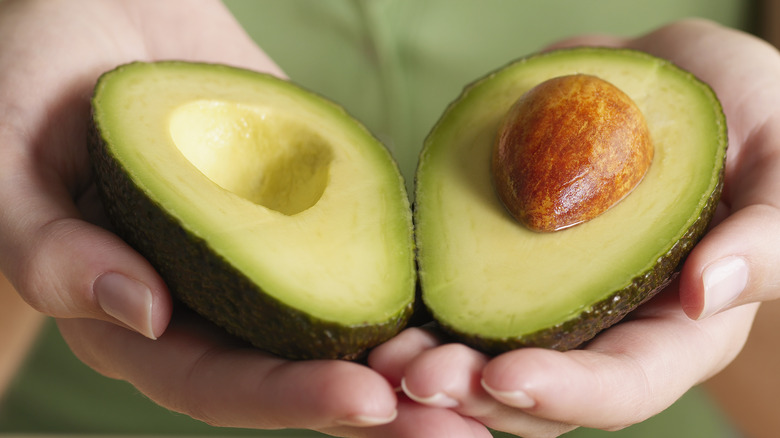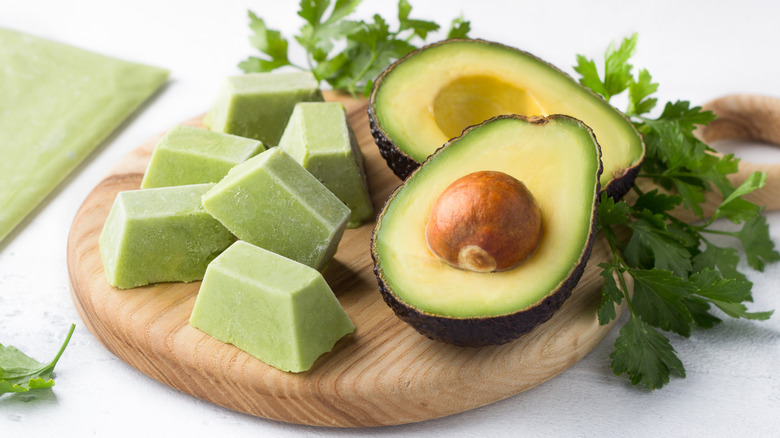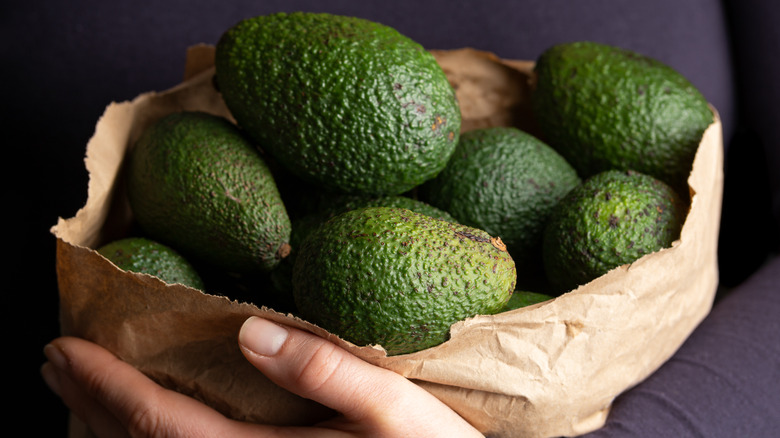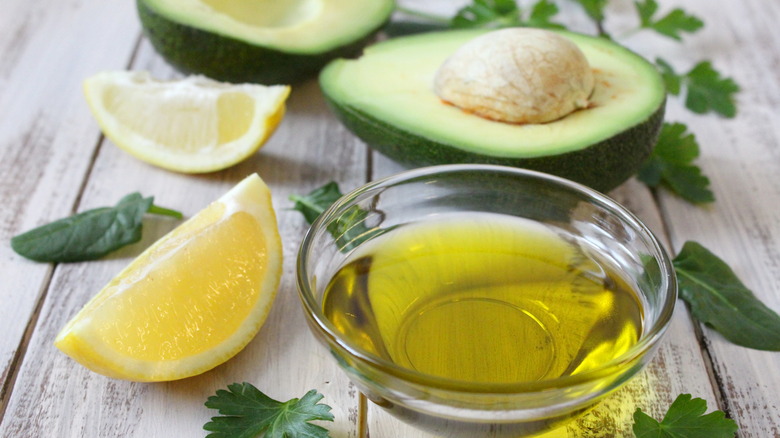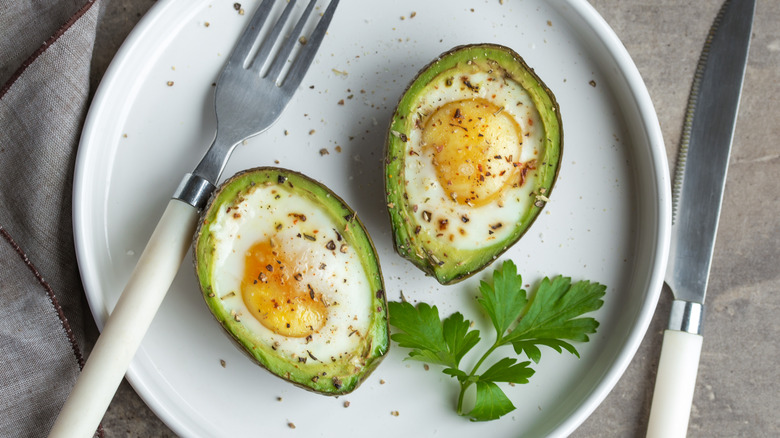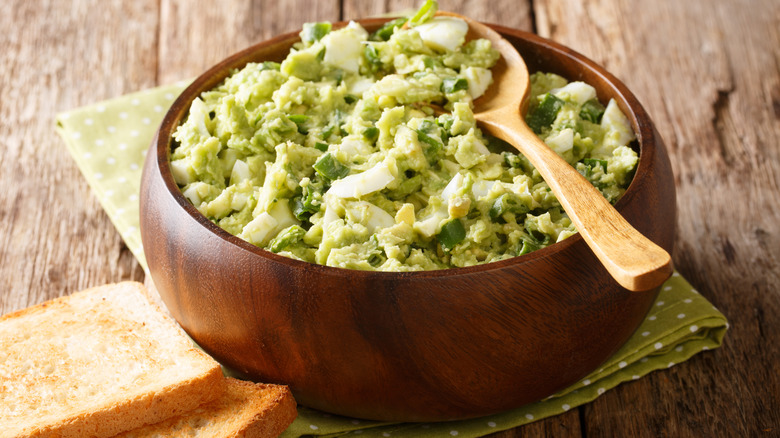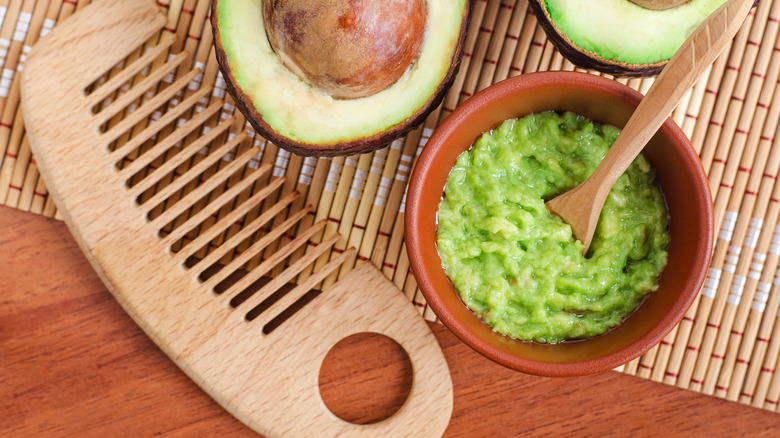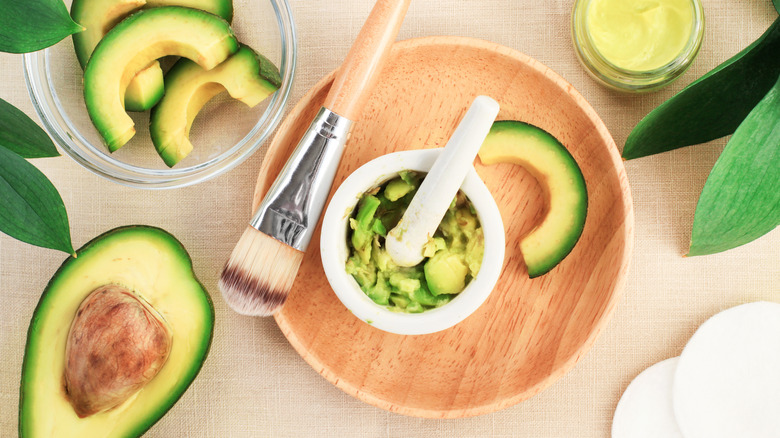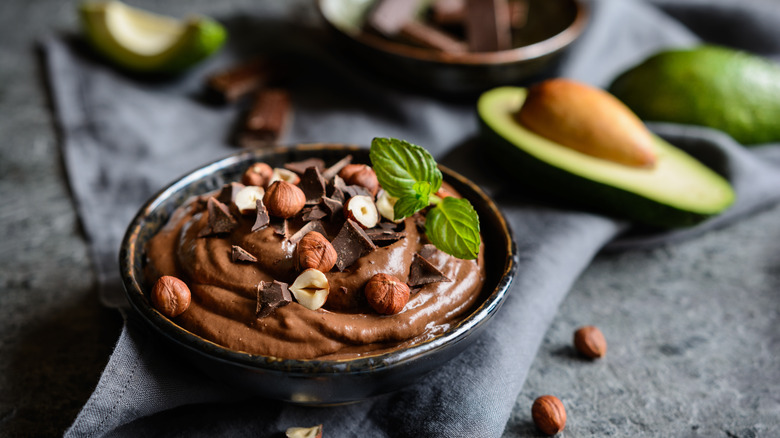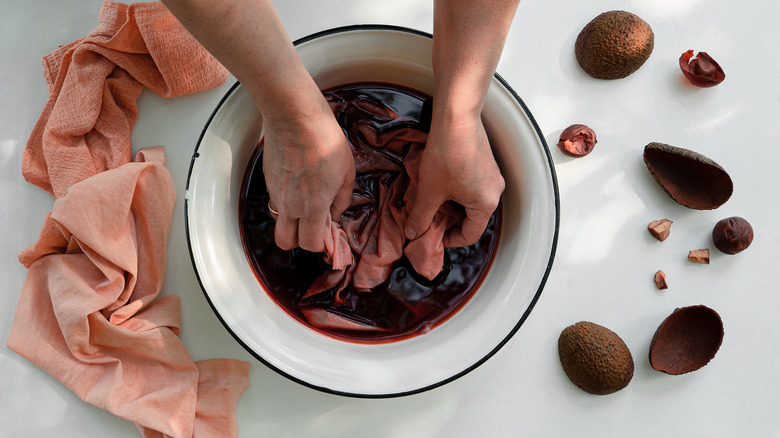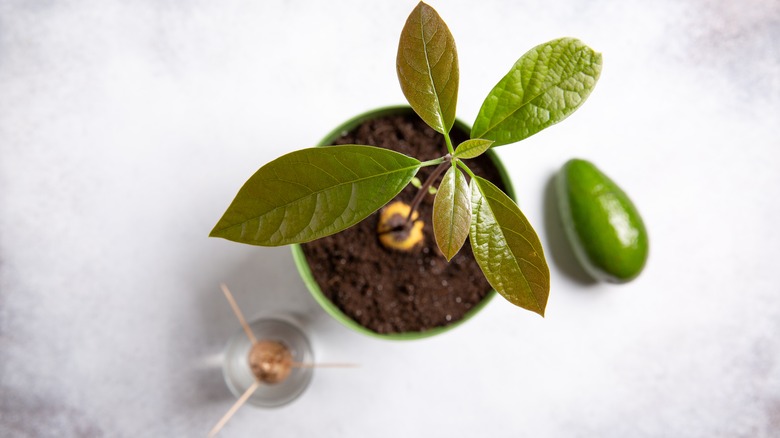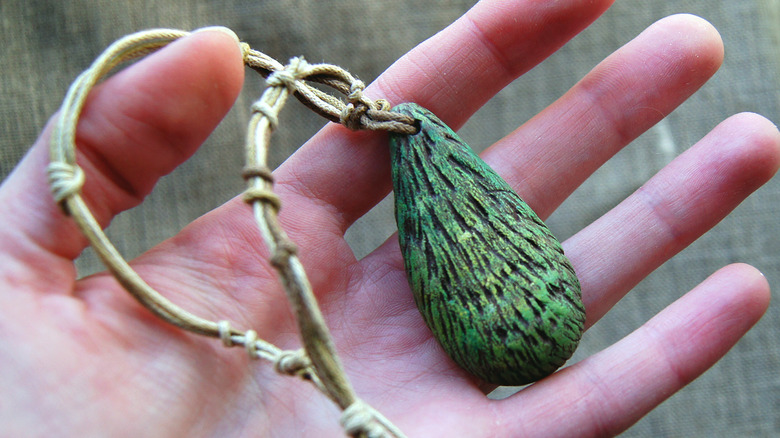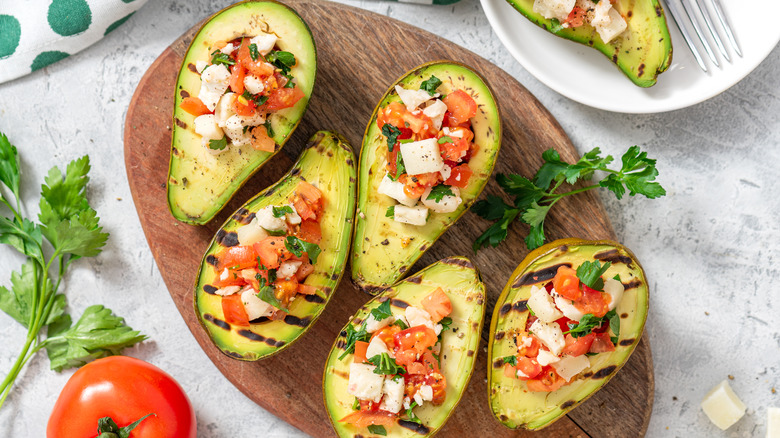12 Best Avocado Hacks You've Never Heard Of
Avocados bring a lot more to the table than just a bowl of guacamole or a trendy spread on toast. The heart-healthy fruit is rich in fiber and potassium, and loaded with vitamins, healthy fats, carotenoids, and other nutrients (via Harvard University). Avocados are mild in flavor, and can be added to pretty much any dish from smoothies to breakfast scrambles, sandwiches, salads, sauces, soups, dips, spreads, and even desserts.
One the most versatile fruits out there, avocados can be mashed, slice, diced, grilled, blended, pureed, sauteed, baked, and more. And there are so many unique uses for avocados that you may have never even thought of, from cooking an egg inside the peel, to creating a DIY facemask with the flesh, and even growing your own house plants by saving the pits. With some many possibilities, we decided to round up a list of the best hacks out there so you can get creative with this creamy, green fruit and make the most of your next avocado purchase.
1. Freeze avocado to increase shelf life
With grocery store prices on the rise, buying single avocados can be much more costly than buying in bulk. But what are you supposed to do with all those extra avocados in the bulk bag? If you're not making guacamole for a large party and you don't intend to eat avocado toast for every meal, then you might find yourself with a lot of extra avocados that you don't know what to do with. But not to worry — one way to extend their shelf life and keep them at peak ripeness is to freeze them.
California Avocado recommends mashing the fruit to your preferred texture and adding a squeeze of lemon juice before spooning the ingredients into a freezer bag for storage. You can also use a freezer-safe container, but you'll want to place a piece of wax paper or saran wrap on top of the mashed avocado to prevent the air from turning the avocado brown. Your frozen mashed avocado can then be used in smoothies, on toast, or in dips and spreads like guacamole for up to one month after freezing.
Another surprising hack for freezing avocados is to simply leave them whole, with the skin on, and place them in the freezer for up to two or three months (via Food Network). Once you're ready to consume your frozen avocado, thaw it on the counter until it's ready, then consume it promptly, as a thawed avocado will turn brown quickly.
2. Quicken the ripening process by brown bagging it
There's nothing quite as disappointing as shelling out a couple of bucks on an avocado only to get home from the grocery store and find that it's not ripe enough to eat right away. Unripe avocados are a common issue when buying in bulk, which has the advantage of being more budget-friendly, but doesn't always allow you to do a light squeeze test on each individual avocado to make sure they're ripe to your satisfaction.
Although there are a slew of hacks to ripen an avocado faster, like popping it in a 200F oven or zapping it really quickly in a microwave, but these quick tricks aren't full-proof, and often leave you with an unappealing, brownish-green avocado that has a funky taste. According to Clean Eating, the brown bag method is the best way to quickly ripen your avocado. To achieve the best result, place your unripe avocado in a brown bag with a ripe banana, or another ethylene-gas producing fruit, like an apple or kiwi. Close the brown bag and leave it on your counter at room temperature. By the next day, your once rock-hard avocado will now be ripe and creamy.
3. Keep your cut avocado fresh with a few simple tricks
If you only need a few slices of avocado for a sandwich or salad topper, and you want to store the other half in the refrigerator for your next meal, there's some extra steps you may want to take to ensure your avocado remains green and tasty. Much like apples, avocados turn brown when their flesh is exposed to air. And a ziplock bag or plastic container will not ensure your avocado won't turn brown, so don't just throw it in a bag and hope for the best, as you'll likely be disappointed. The best way to prevent oxygen from reaching the fruit's flesh and causing it to turn brown is to wrap it tightly in saran wrap. Adding a squeeze of lemon juice on the flesh before wrapping it also helps, as the citric acid serves as a protective barrier against the browning effects of oxygen.
Another tip to prevent browning is to store the avocado in an airtight container with some chopped red onions, which will release vapors that prevent the avocado flesh from browning. Place the avocado on top of the onions with the flesh side facing up to avoid any transfer of onion taste to your fruit. Another option to keep your cut avocado fresh is to brush the flesh with olive oil, which acts as a barrier between air and the fruit, therefore prolonging the process of browning.
4. Bake an egg in an avocado half
While chicken, turkey, mushrooms, or bell peppers are more well-known options for foods that can be stuffed, avocados are another food you can fill. And it's a crafty way to reduce your kitchen clean up time while adding to your meal creativity. Eggs and avocado are commonly eaten together, so it only makes sense to try an egg baked inside an avocado. According to Tip Hero, baking an egg inside avocado halves rather than the more traditional method of baking the egg inside bread is also a low-carb substitution for breakfast.
Depending on the size of your avocado, the pit, and the egg you'll be using, you'll want to decipher how much of a hole to dig out. Any avocado flesh you remove to make room for the egg can be used as a garnish on top before serving. Once you've scooped out enough flesh to make room for an egg without it overflowing, you'll want to place the avocado halves in a cupcake pan to keep it from toppling over, then gently pour an egg inside each hole. Bake your egg and avocado until the egg is cooked to your liking, then season it with your preferred flavors. The duo delivers a winning combination of protein, fiber, potassium, vitamins, healthy fats, and amino acids (via Downshiftology).
5. Use avocado in place of butter or mayonnaise
With a mild flavor and creamy texture, avocados are a very versatile fruit that can be used with sweet and salty foods alike. As a healthy fat that is packed with nutrients and vitamins, avocados can also serve as a heart-healthy substitute to other saturated fats and cholesterol-boosters like butter and mayonnaise, according to California Avocado. When swapping out butter for avocado in a recipe, the general rule of thumb is to use a 1 to 1 ratio. So if your recipe calls for half a stick of butter, or 8 tablespoons, you'll want to use 8 tablespoons of avocado instead.
Another way to increase the healthy fats and amino acids in your diet while decreasing your saturated fat intake is to swap out mayonnaise for avocado in recipes like tuna salad, egg salad, or chicken salad. In these recipes, you can mash the avocado for a chunkier dressing, or blend it to a puree and mix it with other ingredients like mustard, lemon juice, or olive oil until you get a creamy, mayonnaise-like texture, as recommended by the Produce for Better Health Foundation. Avocados can also be swapped for mayonnaise in salad dressings and sauces.
6. Make your locks shine with a DIY hair mask
For shiny, moist, and healthy locks, give your wallet a rest and whip together your very own DIY avocado hair mask. Although there are many avocado-infused hair masks on the market, you don't need to run to the store to give your hair the nourishment that it needs. In fact, the best results come straight from the source, according to Mind Body Green. Rich in vitamins A, B, C, E, and K, as well as nutrient-dense fatty acids, avocado conditions every inch of hair from a dry scalp to split ends. It can be applied to your hair by itself, or with a concoction of other hair-healthy foods found in your kitchen.
Poosh recommends adding lemon juice, olive oil, and honey to your avocado hair mask to yield the smoothest, shiniest results. Leave the homemade solution on your hair for up to 45 minutes before rinsing it. The lemon will help clarify your locks while giving your scalp a deep antibacterial cleanse, the honey helps moisturize, and the olive oil protects hair against heat and color treatments. Other avocado hair mask ingredients you probably have in your kitchen cupboard include coconut oil, bananas, oatmeal, eggs, and essential oils.
7. Or create a DIY face mask
Whether your goal is to save money, be more in tune with mother nature, or create your own non-toxic beauty product, a DIY avocado face mask is a way to accomplish all of the above. The fruit is loaded with moisturizing fatty acids, antioxidants, and an array of vitamins and nutrients that are known to nourish everything from your appetite to your hair to skin. Another face-boosting benefit to avocado is the amount of chlorophyll found in the fruit, which is responsible for their signature green pigment, and may also help improve acne-prone skin. And making an avocado face mask is as easy as whipping up a bowl of guacamole, according to Mind Body Green.
Whether pampering yourself or applying a face mask during your morning or nighttime skincare routine, spreading creamy avocado directly on your face is a great way to make use of this nutrient-dense superfood. Adding honey, some yogurt, and egg yolk will take your DIY avocado face mask to the next level, per DIY Natural, thanks to the moisturizing, nutritive combination. Other options to add to your DIY avocado mask mix include bananas, aloe vera, olive oil, or moringa powder. But one piece of advice — before you go spreading a concoction of these ingredients on your face, it's best to do a patch test to make sure your DIY mask is a match with your skin type.
8. Make dessert healthier with avocado
It may sound like an oxymoron, but healthy dessert is possible, especially when you make avocado the star, or at least a supporting ingredient in your homemade sweet treats. Since this creamy green food is in fact a fruit, it shouldn't come as a surprise that avocado pairs well with most sweet ingredients, and its mild flavor makes it a healthy substitute for butter in most dessert recipes.
California Avocado offers a few dessert options where avocado is replaced for butter in a 1 to 1 ratio, including dark chocolate mousse, frozen berry popsicles, and chocolate fudge muffins. In many parts of the world where avocado grows in abundance, like Brazil and many parts of Asia, avocado is often served as a creamy milkshake dessert, per AvoSeedo. Avocado shakes are not only nutritious but also versatile and can be served as an after dinner dessert or a sweet start to the day.
9. Dye your clothes with avocado pits
Whether you're looking to waste less in the kitchen, become your own fashion designer, or create non-toxic products to use at home, dyeing your clothes with an avocado peel will accomplish any of the above — so long as you're okay with it having a rose-colored pink hue. As explained by self-care brand Somebody, avocado pits are an effective natural dye that is also pretty beginner-friendly.
In order to create your avocado pit-dyed, pink masterpiece, you'll want to give yourself at least two hours, or up to two days, to accomplish the task. You'll need two stainless steel or aluminum pots, along with a stainless steel colander, a wooden spoon, and hot water. In terms of fabric, protein fibers work best, such as silk or wool, but natural fibers like cotton and linen will take to the dye as well. The amount of avocado pits you'll need depends on the weight of your fabric; the general rule of thumb is one pound of pits for every two pounds of fabric.
From there, simply simmer your pits in water for several hours to make a deep red concentrated dye, then strain and add to a large pot of hot water. Next, add your fabric and let the dye work its magic for several hours or days (stirring it around occasionally) until your desired hue is achieved. Once you're ready, remove the fabric, rinse, and hang it up to dry.
10. Grow your own avocado tree
Did you know you can use a leftover pit to grow your own avocado tree? As Almanac points out, this method of regrowing the pit into a plant does not produce a fruit tree that yields more avocado, but it does allow you to grow your own pretty house plant, which is well worth the endeavor.
The first step is to gently peel a ripe avocado, being careful not to cut the pit with your knife. Rinse the pit in water and leave it on the counter to dry for up to three days. Next, with the pointed end facing upwards, insert three toothpicks around the center of the avocado pit, and rest it over a jar filled with room temperature water. The flat end of the avocado should be resting in the water, and the pointed end facing upwards out of the jar. Set the glass in a warmer location in your home with indirect sunlight, and change the water regularly.
Within a few weeks, roots will begin to sprout from the bottom of the pit. Once the roots are strong and sturdy, and are approximately 3 inches in length, you can transfer the pit to a pot of soil, pointed end up, and watch it grow into a large green houseplant.
11. Get crafty using avocado pits
If using an avocado pit to dye your clothes or grow a houseplant isn't in your wheelhouse, then maybe you'll enjoy using the pit for a DIY crafting project. As Avocados from Mexico suggests, you can try carving avocado pits to create jewelry pieces and carve figurines. You want to make sure you're starting with a perfectly dried pit, which means leaving the it on the counter for several days until the skin starts to flake away.
Once your pit is dry and ready to go, you can let your imagination wander to create your avocado artwork. Use a precision knife or any other tool that is sharp enough for carving, such as a screwdriver. You can split the pit in half so you can lay it on a flat surface for steadier carving. Then slice into the rounded side, carving it like a mini pumpkin to create faces, drawings, or miniature animals. You could also try breaking the pit up into smaller pieces to use as beads for a necklace, or drilling a hole through the center of the pit to use it as a charm. Once your crafty masterpiece is complete, let it dry for a day, and then rub it with avocado oil to give it a smooth texture.
12. Grill avocados for a warm, charred flavor
While commonly used in dips, spreads, and smoothies, avocado can also be served warm. And you can even throw it on the grill to give it a smoky, charred flavor. Switch up the flavors of your guacamole by using grilled avocado, or add your grilled avo to salsas, as a taco topping, or in any salad, hot or cold. The char-grilled meatlike flavor will surely impress your guests and take any side dish to the next level.
For the best results, Avocados from Mexico recommends cutting the fruit lengthwise, removing the pit, then brushing the flesh with oil before placing it, flesh side down, on a grill heated to 300-350 F. Leave it on for two to three minutes, then remove from the grill and season, stuff, and top your avocados as desired. If you're halved avocados aren't hitting the grill right away, you can add a squeeze of lemon juice to prevent the flesh from browning, while lending a touch of citrus flavor. It's also best to leave the skin on as the flesh is too soft to handle the grill grates alone, and you'll run the risk of losing your precious avocado to the fiery coals or burners.
